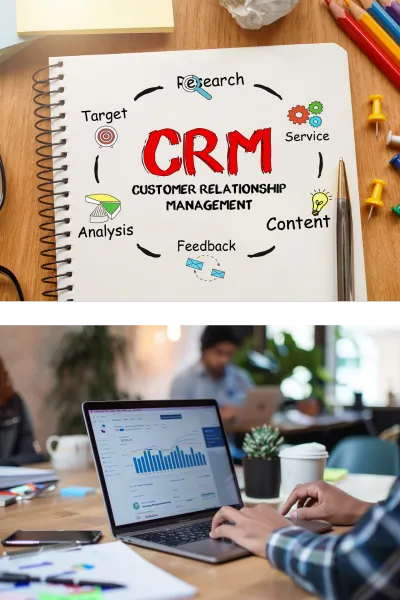
Watch your business grow with Integrated Marketing Pro!
SERVICES AND MANAGEMENT
All-in-one CRM & Management
Organic SEO Creation
Website Design and Build
Reputation and Reviews
Miss-call Text-back Automation
Affiliate Programs
CRM Set-up and Training
Social Media Posts and Planner
Lead Generation
Blog Posts 1 x Weekly
Google Business Profile-Free Leads
Lead Capture Forms
Workflow Automation Design
Ai and Data Integration
Google and Social Media Ads
Integrated Marketing Solutions
START WITH A SOLID FOUNDATION AND SCALE FROM THERE
Use an all-in-one CRM to create, manage and organize all of the above functions.

1. All-In-One CRM
An all-in-one CRM (Customer Relationship Management) solution is necessary for organizing and managing your business for many reasons:
Centralized Information: An all-in-one CRM consolidates all customer data, interactions, and communications into a single platform. This centralization helps ensure that every team member has access to the same, up-to-date information, reducing errors and improving efficiency.
Streamlined Processes: By integrating various functions such as sales, marketing, customer service, and project management into one system, an all-in-one CRM streamlines processes. This integration eliminates the need for multiple disconnected tools and systems, making workflows more efficient and reducing the complexity of managing different platforms.
Automation of Routine Tasks: An all-in-one CRM can automate repetitive tasks such as data entry, email follow-ups, and lead nurturing. This automation saves time, reduces manual errors, and allows employees to focus on more strategic activities.
Comprehensive Reporting and Analytics: CRM systems often come with advanced reporting and analytics features. These tools provide valuable insights into sales performance, customer behavior, and marketing effectiveness, helping businesses make data-driven decisions and refine their strategies.
Improved Customer Service: By having a complete view of customer interactions and history, support teams can respond more quickly and accurately to customer inquiries and issues. This leads to better customer satisfaction and loyalty.
Scalability: An all-in-one CRM solution can grow with your business. As your company expands, the CRM can accommodate additional users, integrate with other tools, and support more complex processes without requiring a complete overhaul of your systems.
Cost Efficiency: Using a single CRM platform reduces the need for multiple software licenses and minimizes the costs associated with managing and integrating disparate systems. It also reduces training costs since employees only need to learn one system.
Data Security and Compliance: A unified CRM system often comes with robust security features and compliance measures. Centralizing data helps ensure that security protocols are consistently applied, making it easier to protect sensitive information and adhere to regulatory requirements.
Enhanced Customer Experience: With all customer data and interactions in one place, businesses can provide a more personalized and consistent experience. This improves customer satisfaction and fosters stronger relationships.
An all-in-one CRM solution is essential for organizing and managing a business because it centralizes information, streamlines processes, enhances collaboration, and provides valuable insights. It helps improve efficiency, customer service, and overall business performance.

2. Speedy Website and Landing Pages
In today’s digital age, having a fast website is essential for several key reasons:
User Experience: A fast-loading website provides a smoother, more enjoyable experience for users. Visitors are more likely to stay on a site that loads quickly and navigate it easily. Slow load times can frustrate users and lead to higher bounce rates, where visitors leave the site before fully engaging.
Search Engine Rankings: Search engines like Google consider page speed as a ranking factor. Faster websites are more likely to rank higher in search results, leading to increased visibility and organic traffic. A slow website can negatively impact your SEO efforts and reduce your site’s chances of being discovered.
Competitive Advantage: In a competitive digital landscape, speed can be a differentiator. If your website loads faster than competitors’ sites, you have a better chance of attracting and retaining visitors. Speed can be a critical factor in users’ decisions on which site to choose.
Reduced Bounce Rates: Slow-loading pages can lead to higher bounce rates, where users leave the site quickly due to frustration or impatience. A fast website helps keep visitors engaged and reduces the likelihood of them leaving before interacting with your content.
Enhanced Engagement: Faster sites enable smoother interactions with content, leading to longer time spent on the site and greater engagement with your content. Users are more likely to explore multiple pages and interact with various elements if the site responds quickly.
Positive Brand Perception: A fast, efficient website contributes to a positive brand image. Users perceive fast-loading sites as more professional and reliable, which can enhance their overall perception of your brand.
Technical Efficiency: Speed optimization often involves improving technical aspects of your site, such as server performance, code efficiency, and image optimization. These improvements not only enhance load times but also contribute to the overall health and maintainability of your site.
In conclusion, a fast website is crucial because it enhances user experience, boosts conversion rates, improves search engine rankings, and provides a competitive edge. It is an integral part of a successful online strategy, impacting everything from user satisfaction to business performance.

3. Organic SEO
Organic SEO (Search Engine Optimization) is crucial for improving your website's visibility on search engines like Google. Here’s why it’s important:
Increased Visibility: Good SEO practices help your website rank higher in search engine results pages (SERPs). Higher rankings mean more visibility to potential visitors who are searching for relevant keywords or phrases related to your content or services.
Cost-Effective: Unlike paid advertising, organic SEO does not require ongoing payments. Once you achieve a good ranking, you can maintain it with ongoing effort and updates, reducing the need for continuous expenditure.
Credibility and Trust: Websites that rank higher are often perceived as more credible and trustworthy. Users tend to trust search engines’ recommendations, so being on the first page of search results can enhance your credibility.
Targeted Traffic: SEO helps attract visitors who are actively searching for the products, services, or information you offer. This targeted traffic is more likely to convert into customers or clients.
Long-Term Benefits: While SEO requires consistent effort, the benefits are long-lasting. Good SEO can continue to attract visitors and generate leads over time, even if you reduce your marketing spend.
Better User Experience: Effective SEO involves optimizing your website’s structure, content, and navigation, which can improve the overall user experience. This can lead to higher engagement, lower bounce rates, and better conversion rates.
Data and Insights: SEO tools and analytics can provide valuable data about your audience’s behavior, preferences, and the effectiveness of your content. This information can help you make informed decisions to improve your website and marketing strategies.
Integrating organic SEO into your website is essential for attracting and retaining visitors, building credibility, and achieving long-term online success.

4. Google Business Profile
Having a Google Business Profile (formerly Google My Business) and keeping it updated is crucial for several reasons:
Enhanced Visibility: Your business profile helps your company appear in local search results on Google Search and Google Maps. This increased visibility makes it easier for potential customers to find you when they're searching for businesses like yours in their area.
Credibility and Trust: An up-to-date profile with accurate information (like address, phone number, and business hours) builds trust with potential customers. It shows that you're active and engaged with your business, which can make people more likely to choose your services or products.
Customer Engagement: Google Business Profiles allow you to respond to customer reviews, answer questions, and engage with your audience directly. This interaction can improve customer satisfaction and loyalty.
Insights and Analytics: Google provides valuable insights on how customers find your business, where they come from, and what actions they take on your profile. This data can help you make informed decisions about your marketing strategies.
Local SEO: A well-maintained profile can improve your local search engine optimization (SEO), helping you rank higher in local search results. This is especially important for attracting nearby customers.
Free Advertising: Google Business Profiles are a free way to advertise your business. You can showcase your products or services, share updates, and promote special offers without any additional cost.
Photo and Post Updates: You can upload photos and create posts about your business, promotions, or events. Regular updates keep your profile engaging and relevant, which can attract more attention from potential customers.
Easy Navigation: A complete profile provides essential information like directions, phone numbers, and website links, making it easier for customers to find and contact you.
In summary, maintaining an updated Google Business Profile helps you attract and retain customers, improve your online presence, and gain valuable insights into your business's performance.

5. Blog Posts 1 X per week
Publishing blog posts once a week can be a strategic approach to maintaining an active online presence and achieving various benefits. Here’s why it’s important:
Consistency Builds Audience Engagement: Regularly publishing blog posts helps keep your audience engaged and coming back for more. Consistent updates demonstrate that your site is active and provide fresh content for readers to explore.
Improves SEO: Frequent blog posts can enhance your website's SEO. Search engines favor websites that are regularly updated with relevant, high-quality content. Posting once a week helps keep your site fresh and can improve your chances of ranking higher in search results.
Increases Website Traffic: Regular blog updates provide more opportunities for your site to be found in search engines. Each new post can attract new visitors and drive more traffic to your site.
Establishes Authority and Expertise: Weekly blog posts allow you to cover various topics in your industry, showcasing your knowledge and expertise. This can help position you as an authority in your field and build trust with your audience.
Engages with Your Audience: Regular content gives you the chance to address current trends, answer common questions, and provide valuable insights. This ongoing dialogue can foster a stronger connection with your audience.
Builds a Content Library: Over time, weekly posts contribute to a robust content library on your site. This archive can be a valuable resource for your audience and can enhance your site’s authority and relevance.
Encourages Interaction and Feedback: Regular posts provide more opportunities for interaction with your audience through comments, shares, and feedback. This can lead to valuable insights and further engagement.
Supports Long-Term Growth: Consistent blogging can contribute to long-term growth by continually attracting new visitors, retaining current ones, and improving your site’s search engine rankings.
Overall, publishing blog posts once a week can help you maintain an active online presence, engage with your audience, and achieve various marketing and SEO goals.

6. Stop the Scroll
When everything above is on track with minimal expense, you can start to explore paid digital ads. Stopping the scroll is crucial in digital advertising because it directly impacts the effectiveness of your ads. Here’s why it’s so important:
Capture Attention: In a digital environment flooded with content, users quickly scroll through their feeds. To stand out, your ad needs to grab their attention immediately. If you don’t stop their scroll, your ad won’t be seen or remembered.
Increase Engagement: Ads that capture attention are more likely to be engaged with. Stopping the scroll encourages users to interact with your ad, whether it’s through clicks, likes, shares, or comments. This engagement can lead to higher conversion rates.
Create a Strong First Impression: The first few seconds of an ad are critical. If your ad fails to stop the scroll, it won’t create the impactful first impression necessary to pique interest and drive further action.
Drive Higher Quality Leads: When users are stopped by an engaging ad, they’re more likely to be genuinely interested in what you’re offering. This can lead to higher-quality leads and more meaningful interactions.
Enhance Ad Relevance: Ads that successfully stop the scroll are often more relevant to the target audience. By crafting compelling visuals and messages tailored to your audience, you increase the likelihood that they will pay attention and take action.
Differentiate from Competitors: In a competitive digital landscape, attention-grabbing ads help you stand out from competitors. By stopping the scroll, your ad can cut through the noise and draw users’ focus to your unique selling points.
Maximize Ad Placement Value: Many digital ad platforms use algorithms that reward high-engagement ads with better placement and lower costs per impression or click. Ads that effectively stop the scroll can benefit from these algorithms, improving their overall performance.
Encourage Action: Ultimately, the goal of digital ads is to drive users to take action, whether it’s making a purchase, signing up for a newsletter, or visiting your website. By stopping the scroll, you increase the chances of users taking the desired action.
In summary, stopping the scroll is crucial because it directly affects the visibility, engagement, and effectiveness of your digital ads. By capturing users’ attention and making a strong impression, you can improve your ad performance and achieve your marketing goals more effectively.
Choose the CRM system that best suits your business:
With an all-in-one CRM, you will be able to create and manage all of the functions mentioned above.
GET STARTED TODAY WITH A 7-DAY FREE TRIAL

Starter System
$99
Monthly
(Pay annually and get 2 months free)
PERFECT FOR GETTING STARTED
CRM
Missed-call Text-back
One (1 ) User and 300 Contacts
Website Chat Widget
Interactive Dashboard
Social Planner
Reputation Management

LAUNCH SYSTEM
$199
Monthly
(Pay annually and get 2 months free)
AUTOMATE AND ORGANIZE
Everything in Starter System
All the Tools to Capture More Leads
Nurture and Close Leads into Customers
Online Booking, Pipelines & Social
Three (3) Users & 1500 contacts
Websites & Forms
Invoicing & Payments
PRO SYSTEM
$279
Monthly
(Pay annually and get 2 months free)
SCALE YOUR BUSINESS
Everything in Launch System
API Access- Integrate with Anything
Affiliate Manager
Unlimited Users and Contacts
Workflow Assistant
Creative Templates
Triggers and Links
Membership and Courses
Surveys
Marketing Assistance
I agree to the terms and conditions provided by Integrated Marketing Pro. By providing your information, you agree to receive communication regarding you account. We value your privacy and will not share your information with any 3rd party.

Find your Way Around
Contact Us
2025 © Integrated Marketing Pro. All Rights Reserved